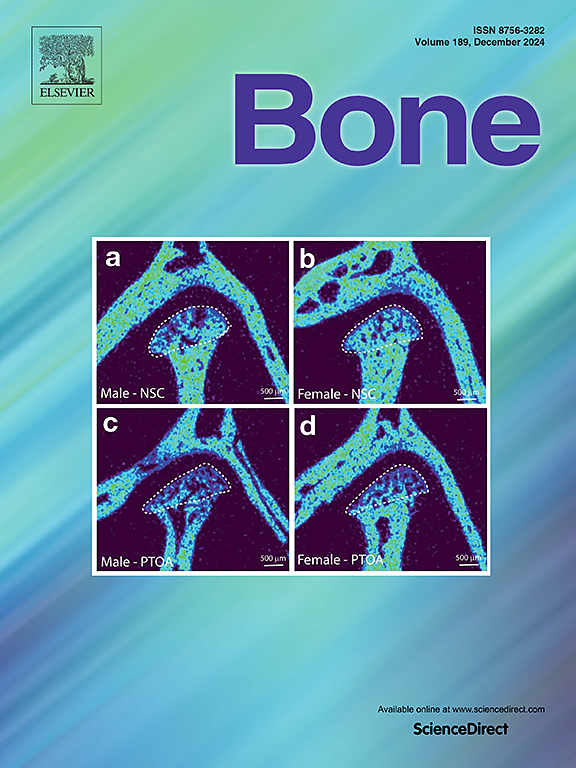Global burden of injury due to low bone mineral density in adults aged 55 years and older, 1990 to 2021: A population-based study
IF 3.5
2区 医学
Q2 ENDOCRINOLOGY & METABOLISM
引用次数: 0
Abstract
Objectives
This study aimed to assess the global burden of injuries due to low bone mineral density (BMD) among adults aged 55 and above from 1990 to 2021, focusing on mortality and disability-adjusted life years (DALYs) and analyzing trends across sexes, age groups, and sociodemographic index (SDI) regions.
Methods
Data from the Global Burden of Disease Study 2021, covering 204 countries and territories, were analyzed. Joinpoint regression quantified temporal changes in mortality and DALYs, calculating average annual percentage change (AAPC). Age-period-cohort modeling elucidated demographic influences, and decomposition analysis identified key contributors to mortality changes.
Results
Globally, in 2021, the crude DALY rate for injuries due to low BMD was 900.32 (95 % UI: 742.64 to 1081.51) per 100,000, and the crude mortality rate was 27.04 (95 % UI: 22.49 to 30.75) per 100,000. The age-standardized mortality rate for injuries due to low BMD showed no significant change from 1990 to 2021 (AAPC 0.26 %, P = 0.071), but there was a significant increase in countries with a high SDI (AAPC 0.51 %, P = 0.001). The burden of disease in persons aged 80 years and older remained substantial, with a slight increase. Decomposition analysis identified population growth as the main driver of increasing mortality and DALYs.
Conclusion
Despite the reductions in DALY rates, the mortality has remained stable worldwide; however, has risen significantly in high SDI countries. The substantial and slightly increasing burden of disease in people aged 80 years and older underscores the need for targeted strategies for the prevention and management of low BMD to mitigate the future global impact of these injuries.
1990年至2021年55岁及以上成人低骨密度造成的全球损伤负担 :一项基于人群的研究
目的:本研究旨在评估1990年至2021年55岁及以上成年人因低骨密度(BMD)造成的全球伤害负担,重点关注死亡率和残疾调整生命年(DALYs),并分析性别、年龄组和社会人口指数(SDI)地区的趋势。方法:分析来自2021年全球疾病负担研究的数据,涵盖204个国家和地区。连接点回归量化了死亡率和DALYs的时间变化,计算了平均年百分比变化(AAPC)。年龄期队列模型阐明了人口统计学的影响,分解分析确定了死亡率变化的关键因素。结果:全球范围内,2021年低骨密度损伤的粗DALY率为900.32(95 % UI: 742.64 ~ 1081.51) / 10万,粗死亡率为27.04(95 % UI: 22.49 ~ 30.75) / 10万。从1990年到2021年,低骨密度损伤的年龄标准化死亡率没有显著变化(AAPC 0.26 %,P = 0.071),但在SDI高的国家有显著增加(AAPC 0.51 %,P = 0.001)。80岁 岁及以上人群的疾病负担仍然很大,略有增加。分解分析确定人口增长是死亡率和伤残调整生命年增加的主要驱动因素。结论:尽管DALY率有所下降,但世界范围内的死亡率保持稳定;然而,在SDI高的国家却显著上升。80岁( 岁)及以上人群的疾病负担显著且略有增加,这表明需要有针对性的策略来预防和管理低骨密度,以减轻这些损伤的未来全球影响。
本文章由计算机程序翻译,如有差异,请以英文原文为准。
求助全文
约1分钟内获得全文
求助全文
来源期刊

Bone
医学-内分泌学与代谢
CiteScore
8.90
自引率
4.90%
发文量
264
审稿时长
30 days
期刊介绍:
BONE is an interdisciplinary forum for the rapid publication of original articles and reviews on basic, translational, and clinical aspects of bone and mineral metabolism. The Journal also encourages submissions related to interactions of bone with other organ systems, including cartilage, endocrine, muscle, fat, neural, vascular, gastrointestinal, hematopoietic, and immune systems. Particular attention is placed on the application of experimental studies to clinical practice.
 求助内容:
求助内容: 应助结果提醒方式:
应助结果提醒方式:


